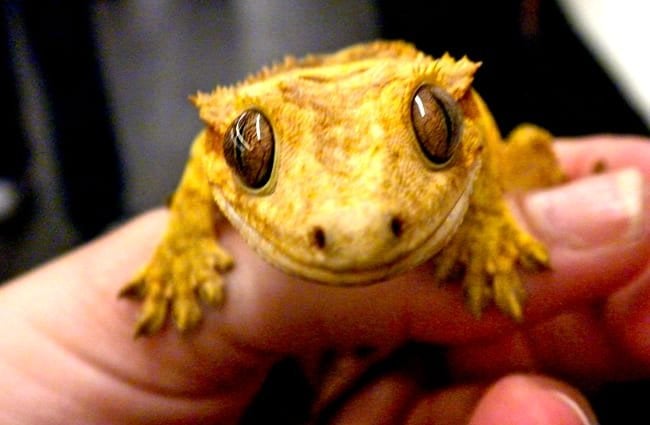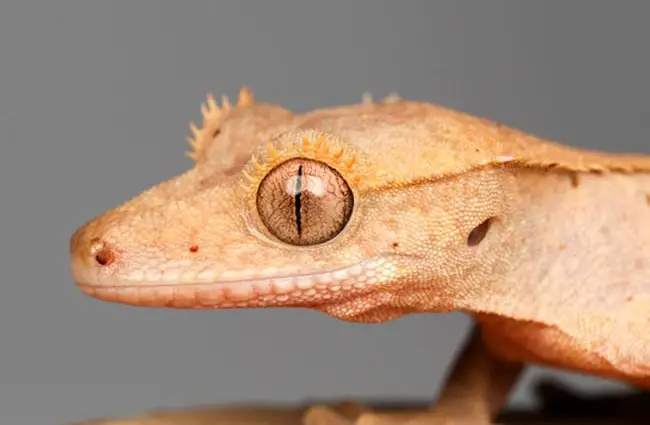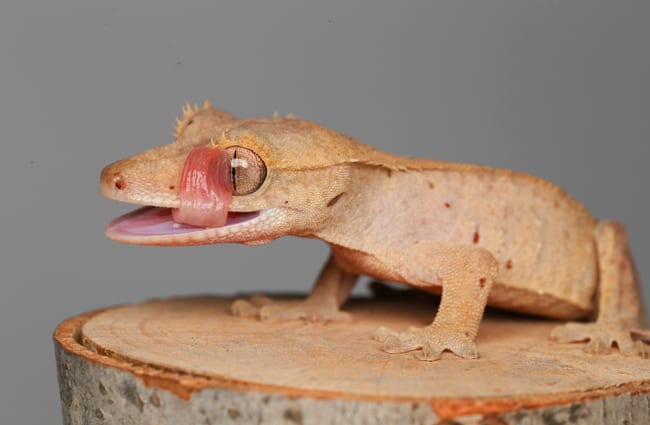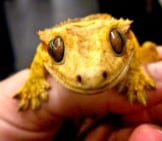These unique-looking reptiles have an even more unique story! Once thought to be extinct, they were rediscovered in the late 1990s, and are now a popular pet. This creature’s natural habitat is a small island off the coast of Australia, called New Caledonia. They have “eyelashes” of ridged skin, and a ridge of skin running down either side of their head and neck. Read on to learn about the crested gecko.
Description of the Crested Gecko
These lizards are some of the largest gecko species, and can be up to 10 in. long. They have a spiny frill of skin the runs over the tops of their eyes, sides of their heads, and down their backs. There are a wide variety of skin colors that occur in the wild, and even more that occur via captive breeding. Some colors include grey, yellow, brown, and red.
Interesting Facts About the Crested Gecko
These cute little lizards are uniquely shaped, and have a number of interesting adaptations to help them survive. Learn more about these cool creatures below.
- Eyelid-less – Like some other geckos, crested geckos do not have eyelids. To keep their eyes clean, they have an odd way of grooming. These reptiles use their long tongues to lick their eyes clean and moisten it.
- Who Said That! – When most people think of reptiles, especially geckos, they don’t picture vocal animals. Unlike some other reptiles, crested geckos make a decent amount of noise! They will bark and squeak in a wide variety of tones.
- An Extra Hand – These creatures are arboreal, which means that they live much of their lives in trees rather than on the ground. To help keep them from falling, they have a prehensile tail. Their tails can be wrapped around branches and twigs to give a little extra stability.
- Lamellae – Another great climbing adaptation is their oddly shaped feet and toes. The pads of a gecko’s toes have unique ridges called lamellae, which can be used to climb very slick surfaces. They can even climb glass!
Habitat of the Crested Gecko
Crested geckos live in a small pocket of land on an island off the coast of Australia. Because they have such a restricted range, they also have a very restricted habitat. They are found only in the rainforests of New Caledonia. Within the forest they live in and around the canopy.
Distribution of the Crested Gecko
Outside of human care, these creatures are found only on the island of New Caledonia. Within the island, they are found only in the South Province. Three separate populations are found within this small area.
A small offshore island, called the Isle of Pines, holds one population. The other two are located on the main island, Grand Terre. These creatures are found no where else in the world in nature.
Diet of the Crested Gecko
These reptiles are omnivorous. While they will feed on insects, they also eat fruit, which makes them a frugivore as well. In the wild, they will prey upon any insect that they can capture, including flies, mosquitos, larvae, and more.
Crested Gecko and Human Interaction
The biggest threat to these geckos in the wild is the introduction of an invasive species, the little fire ant. The ants both attack the lizards themselves, and they compete for insect prey. Their wild populations are still being assessed to determine how much of a threat this poses.
Domestication
Crested geckos have not been kept in human care for a long enough period to even begin to become domesticated.
Does the Crested Gecko Make a Good Pet
These reptiles are commonly kept as pets, but as with any other cold-blooded animal, they require some specialized care. Always do your research before purchasing a pet. These relatively fragile creatures should be handled with care, and young children should be supervised if they are permitted to handle them.
Crested Gecko Care
These geckos should be provided with an appropriately-sized habitat. They like to climb, so vertical space is extremely important, as is a variety of branches and plants. Daytime and nighttime temperature ranges are different, and must be adjusted accordingly.
Humidity should also be kept consistent based on the recommendation of your breeder or veterinarian. Fresh water should be provided at all times, and your gecko should be fed nightly. A commercial crested gecko food is available, and treats of crickets, mealworms, and baby food, can be provided.
Behavior of the Crested Gecko
During the daytime, these geckos retreat to branches high in the canopy, and crawl into well-hidden spots to rest. They are nocturnal, and emerge at night to search for food.
Hiding during the day is important, as they do not have the same regenerative abilities as other geckos, and cannot regrow their tails. Their diet is more varied than most geckos, and they will feed on both insects and fruits while foraging.
Reproduction of the Crested Gecko
While scientists know very little about their breeding habits in the wild, in captivity these creatures reproduce quite successfully. After mating, the female lays two eggs. She can retain the sperm from mating and keep producing eggs for nearly a year. The eggs will hatch between two and three months after they are laid.











![Red Angus Closeup of a beautiful Red Angus cowPhoto by: U.S. Department of Agriculture [pubic domain]https://creativecommons.org/licenses/by/2.0/](https://animals.net/wp-content/uploads/2020/03/Red-Angus-4-238x178.jpg)












![Red Angus Closeup of a beautiful Red Angus cowPhoto by: U.S. Department of Agriculture [pubic domain]https://creativecommons.org/licenses/by/2.0/](https://animals.net/wp-content/uploads/2020/03/Red-Angus-4-100x75.jpg)

